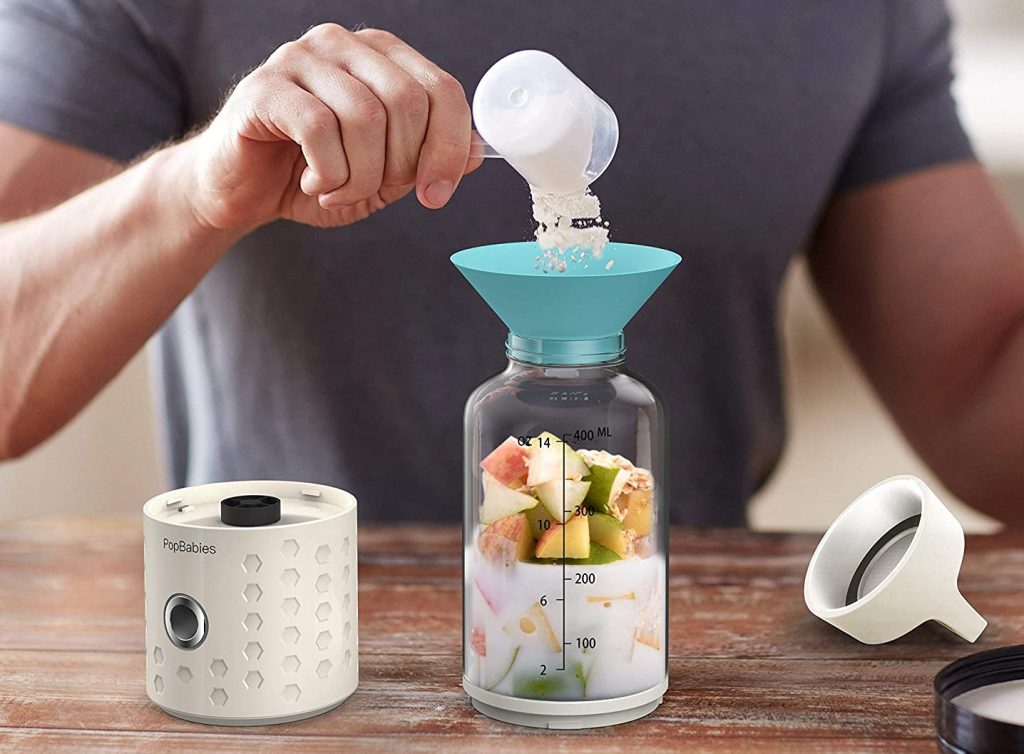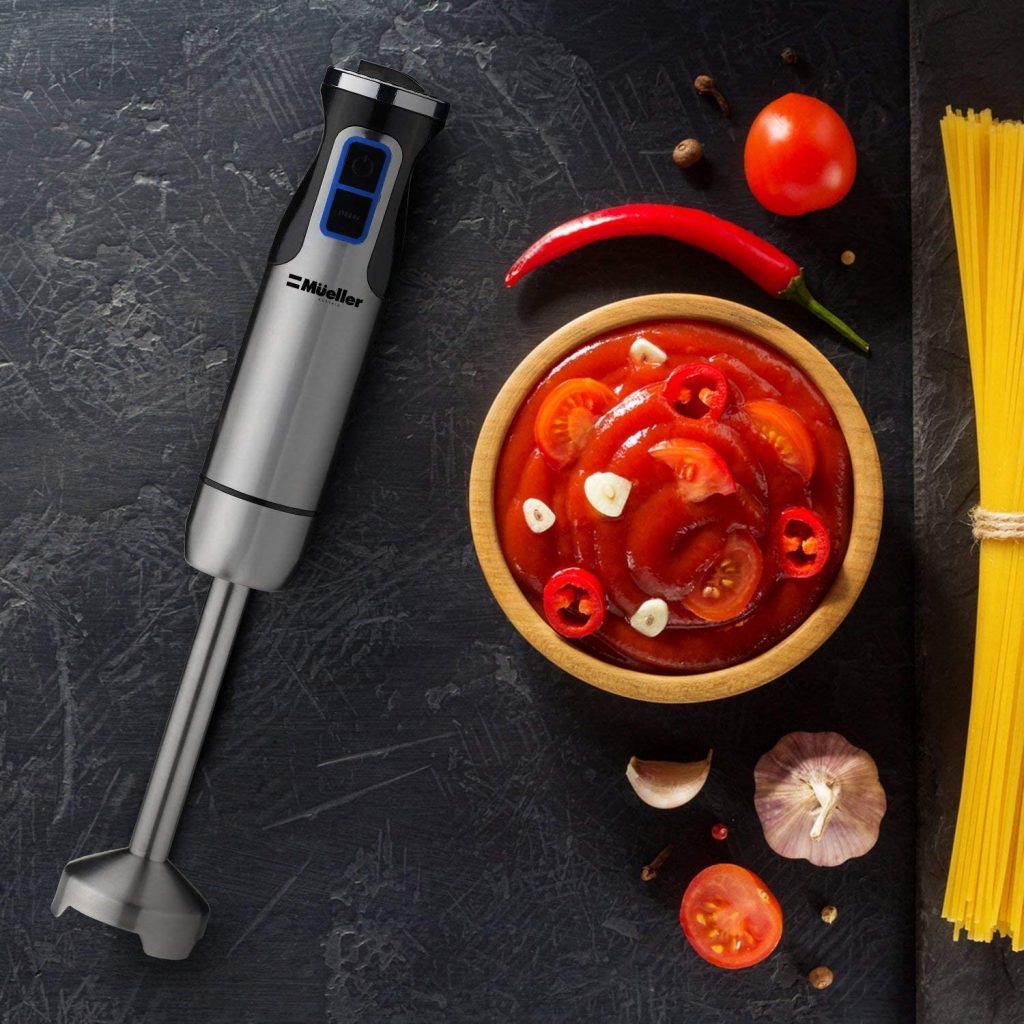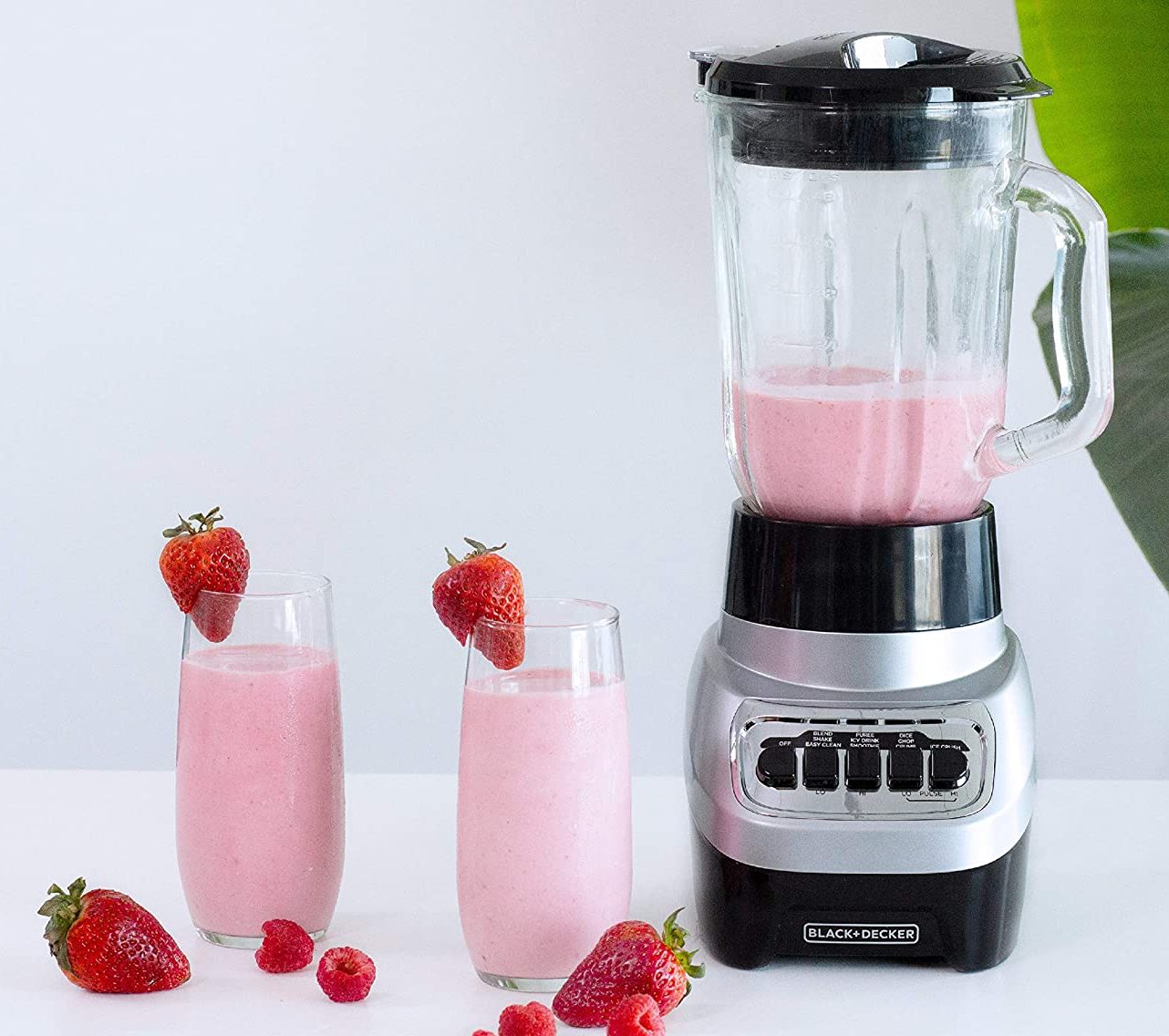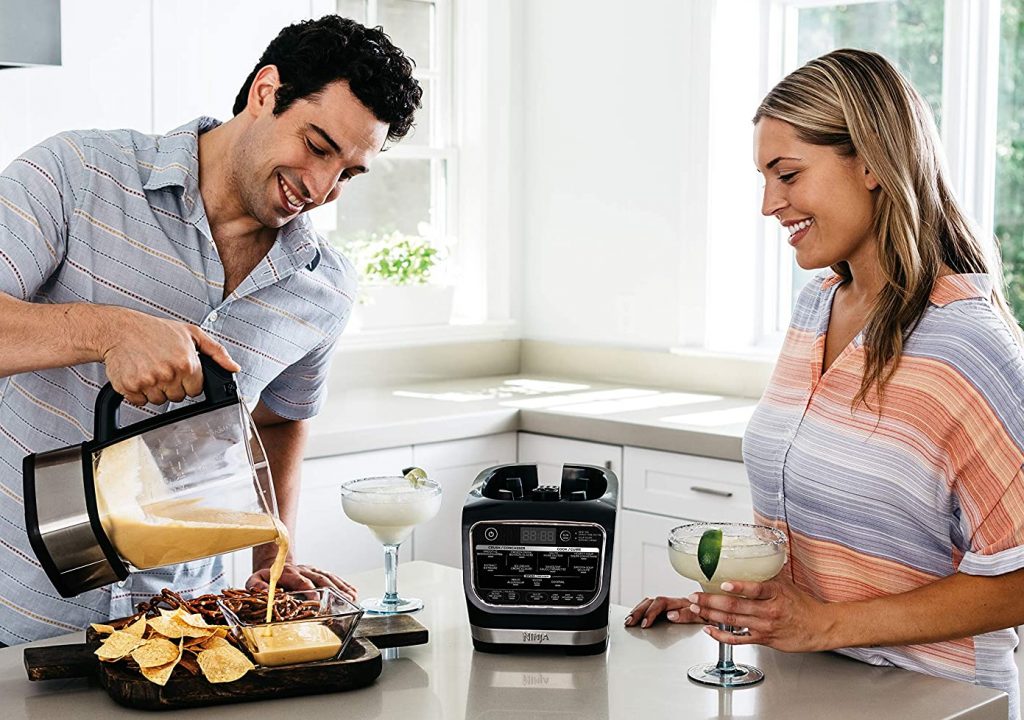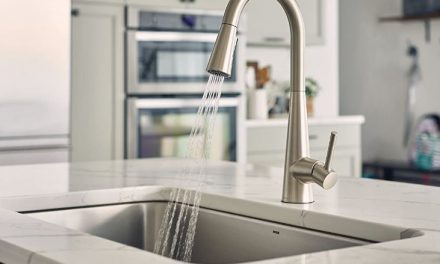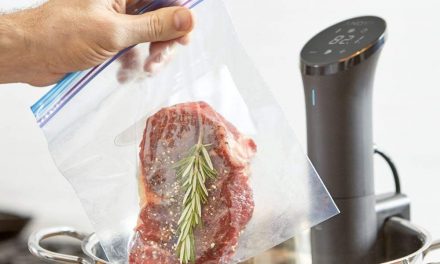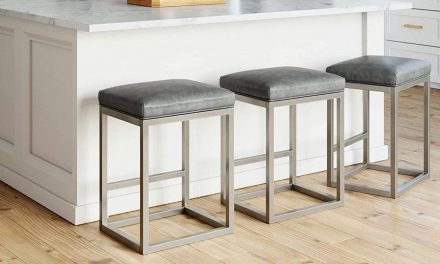From single-serving portable mixers to commercial smoothie makers, the modern blender can massively diversify your culinary options. In this article, we’ll explore what to look for in a blender and how different types of blenders can be used. But first, what does a blender do?
Table of Contents
Types of blenders
Blenders are generally differentiated according to their capacity, power, and who their intended users are.
Single-serve blenders
A newer entry into the blender market, the single-serve blender is perfect for individuals on-the-go and anyone who wants perfect smoothies anytime, as most single-serve blenders are also smoothie blenders. Choose between personal blenders that work more like traditional models and portable, personal blenders that work anywhere from your car to the beach and more.
Blender | Brand & Model | Capacity | Fully Portable? | Jar Type | Other Features | Price |
Oster My Blend Blender | 20 fl. oz. (.6 L) sports bottle | No | Plastic | Includes sports bottle lid | ||
Oster Blend Active Portable Blender | 10 fl. oz. (.3 L) cup | Yes | Plastic | USB chargeable; non-slip grip | ||
Popbabies Portable Personal Blender | 14 fl. oz. (.4 L) cup | Yes | Plastic | USB chargeable; Includes funnel and ice cube tray | ||
NutriBullet Nutrient Extractor | 24 fl. oz. (.7 L) cup | No | Plastic | Includes to-go lid and recipe book | ||
Ninja Nutri Pro Compact Personal Blender | 24 fl. oz. (.7 L) cup and 18 fl. oz. (.5 L) cup | No | Plastic | Includes to-go lids and recipe book |
Immersion blenders (hand blenders)
Immersion (or stick) blenders have similar blade designs to blenders, but instead of bringing the food to the blender, you bring the immersion blender to the food. The blade-end of the immersion blender is put into the food (usually chunky soups or things of a similar texture) to blend them smoother. Since the immersion blender comes to the food, cleanup is a breeze, and you never have to worry about pouring hot soups, stews, and sauces into a blender jar.
Because of this design, however, immersion blenders work best with larger quantities of food, like full pots, and cannot perform some functions that standard blenders can, like crushing ice.
Blender | Brand & Model | Immersion Depth | Cordless? | Weight | Accessories | Other Features | Price |
Mueller Austria Ultra-Stick | 6” (16cm) | No | 2.1 lbs (1 kg) | Whisk and milk frother | Best quality for the price | ||
KitchenAid Cordless Hand Blender | 8” (20cm) | Yes | 2.8 lbs (1.3 kg) | None | Two hours to full charge | ||
Breville Control Grip | 8” (20cm) | No | 2.5 lbs (1.1 kg) | Food processor, jug, and whisk | Non-scratch base | ||
Cuisinart Smart Stick | 8” (20cm) | No | 2.2 lbs (1 kg) | Food processor, jug, and whisk | Steady speed increase prevents splatter | ||
Vitamix Immersion Blender | 9.2” (22cm) | No | 2.9 lbs (1.3 kg) | None | Non-scratch base, anti-suction mechanism |
Full-size blenders
Personal blenders are great for individuals on-the-go, and specialty blenders have their uses. But what if you just want a standard-size blender that can mix and mash and puree a wide variety of foods? That’s where full-size blenders come in.
Blender | Brand & Model | Motor | Capacity | Jar Type | Quiet? | Other Features | Price |
Hamilton Beach Power Elite Blender | 14,500-18,900 rpm | 40 fl. oz. (1.2 L) | Glass | No | None | ||
Black+Decker PowerCrush | 21,000 rpm | 48 fl. oz. (1.4 L) | Glass | No | None | ||
Oster Pro 1200 | 19,000 rpm | 48 fl. oz. (1.4 L) jar and 24 fl. oz. (.7 L) plastic cup | Glass | No | Handles hot and cold foods with ease | ||
Hamilton Beach Quiet Shield Blender | 3,000-18000 rpm | 32 fl. oz. (.9 L) | Plastic | Yes | Rated quietest professional blender on the market | ||
Blendtec Total Classic Original Blender | 4,100-29,000 rpm | 75 fl. oz. (2.2 L) with 32 fl. oz. (.9 L) blending capacity | Plastic | No | Includes blade friction heating; rated best for crushing ice | ||
Vitamix Professional Series 750 Blender | 1,600-31,000 rpm | 64 fl. oz. (1.9 L) | Plastic | No | Its low profile fits under most kitchen cabinets | ||
Vitamix Blending Station Advance | 3,000-22,500 rpm | 48 fl. oz. (1.4 L) | Plastic | Yes | Well-made; blender preferred by Starbucks, Tropical Smoothie, and Smoothie King | ||
Blendtec Stealth 885 Commercial Blender | 30,000 rpm | 90 fl. oz. (2.7 L) with 36 fl. oz. (1.1 L) blending capacity | Plastic | Yes | Well-made; blender preferred by Jamba Juice |
Specialty blenders
From heating elements, to vacuum capabilities, to special smoothie settings, specialty blenders are designed for a unique purpose while also working as ordinary blenders.
Specialty soup blenders (or hot-and-cold blenders) aren’t just blenders that can make soup smooth. They feature heating elements under the jar to saute, simmer, and boil to your heart’s content. And they’re not just for soup. With a soup blender, you can mix hot drinks, blend and prepare sauces, and even make panna cotta while still doing everything you would with a traditional blender.
Vacuum blenders are a fairly recent entry onto the blending scene. Basically, a pump removes the air from the blending jar during use. This prevents excessive aeration of your blends, stops smoothies from separating and losing flavor in the refrigerator, and reduces the oxidation of fruits and vegetables.
There are a wide range of niche blenders on the market, whether for smoothies, smoothie bowls, or dosa batter. While these blenders closely resemble traditional blenders, and can generally still perform all basic blender functions, they are designed with a few specific uses in mind. If you’re looking for a blender that makes restaurant-quality smoothies or comes with a grinder attachment for spices, you’ll find those here.
Blender | Brand & Model | Motor | Capacity | Jar Type | Quiet? | Special Features | Price |
Ninja Foodi Cold & Hot Blender | 13,600-18,500 rpm | 64 fl. oz. (1.9 L) pitcher; 56 fl. oz. (1.6 L) max cold liquids | Glass | No | Hot and cold blending | ||
Instant Ace Plus Cooking Blender | 26,500 rpm | 56 fl. oz. (1.6 L) | Glass | Yes | Hot and cold blending | ||
Pado Ozen 310 Vacuum Blender | 20,000 rpm | 48 fl. oz. (1.4 L) jar and 25 fl. oz. (.7 L) cup | Plastic | No | Vacuum blender | ||
Ninja Foodi Smoothie Bowl Maker and Nutrient Extractor | 20,400 rpm (min and max) | 2 24 fl. oz. (.7 L) cups and 1 14 fl. oz. (.4 L) bowl | Plastic | No | Smoothie bowl maker | ||
Preethi Eco Twin | 10,500 rpm | 50 fl. oz. (1.5 L) jar and 17 fl. oz. (.5 L) chutney jar | Plastic | No | For Indian cooking; also works as spice grinder | ||
Ninja Foodi Professional Countertop Blender | 35,000 rpm | 72 fl. oz. (2.1 L) jar and 2 16 fl. oz (.5 L) cups | Plastic | No | Best large blender for smoothies |
You get what you pay for
While there are many good blender options for less than two hundred dollars, for the diehard blender devotee, a high-end blender might be just what you need.
How blenders work
Basically, a blender is a jar—usually made of glass or plastic—with a specially designed, spinning blade attachment in the base. But these curved, fairly dull blades don’t just cut whatever you put into the jar, like a knife or food processor would. Instead, the rotation draws food down into the blades, where it is then crushed and thrown against the sides of the jar.
By moving through this cycle over and over, whatever you put in the blender reaches a more uniform consistency, be it fruit and yogurt, chunky soup, or, for more powerful blenders, ice and nut butters.
Because of how blenders are designed, they work best for liquid-dominated mixtures, like smoothies and soups. Some high-powered blenders can chop and grind, but for the most part they work best for smoothing and pureeing.
What to look for in a blender
It’s common to ask, “How fast can my blender go?” And that’s a very good question. But sometimes it can be just as important to ask, “How slow can my blender go?” Some high-powered blenders will crush ice and puree frozen fruit all day long, but try to mix a soup or make mayonnaise and you’re out of luck.
The best blenders have a wide range of speeds, allowing you to do everything from stir to pulverize. Plus, better low speed options mean the blender is less likely to burn out. You can always return to a lower setting between pulses for the best of both worlds.
Jar size is another thing that most people will talk about. How much your blender can hold is important, after all. Less commonly discussed, but just as important, is jar shape. America’s Test Kitchen contends that a rounded interior and a smooth, seamless bottom are vital for consistent results. They also suggest that a narrower profile ensures a silky, less aerated consistency for smoothies, making sure you achieve restaurant-quality results every time.
Beyond the size and shape of the jar, the material it’s made out of is also important.
Glass:
- Doesn’t discolor
- Doesn’t absorb food odors
- Less likely to be scratched
- Better for hot mixtures
- Tempered glass is best
Plastic:
- Lighter, so easy to handle
- Tends to be more durable
- Preferred for high-powered blenders
- Cheaper to replace
- Needs to be BPA-free for safety
Noise level is another important blender factor to consider. Traditional blenders are rather loud, with the volume increasing as they become higher and higher powered. Thankfully, modern blenders often come with a wide variety of noise-reduction technologies. Sound enclosures, specialty fittings, and unique designs can quiet a blender more than ever, making it perfect for early morning smoothies or late-night blended drinks.
Some blenders can double as food processors, while others can cook soups and make nut butters. Your blender’s other features might be just as important as mixing, crushing, and pureeing.
To juice or to blend
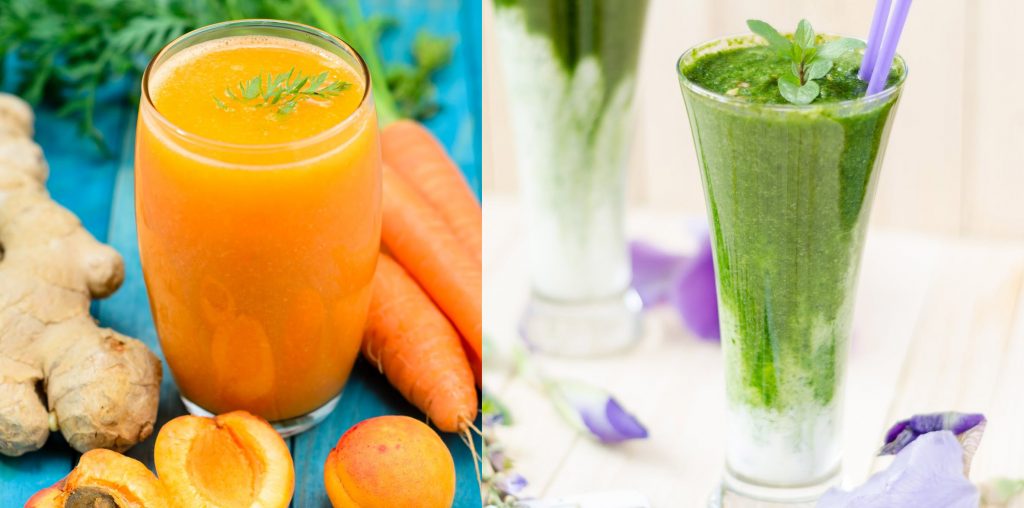
Juice (left) vs. smoothie (right). Public domain images by Alexander Mils from Pexels.
Juices and smoothies are icons of the health food movement. Millions swear by juice cleanses, daily smoothies, and protein shakes. But what are the real differences between juicing and blending?
Simply put: fiber.
Juices don’t have much fiber. All the roughage, soluble or insoluble, in your favorite fruits and vegetables is removed during the juicing process. In addition, evidence suggests that some nutrients may be bound to the fiber itself. Smoothies, by contrast, contain every bit of the fruit or vegetable that you put in the blender. Nothing is separated out.
Juicers might be called extractors—they extract the micronutrients (the vitamins and minerals) as well as the sugar of fruits and vegetables. Blenders just crush everything together into a smooth puree, which means you’ve got both micro and macronutrients (the proteins, fats, and carbohydrates). Both juicers and blenders have their place, but if your focus is on whole foods and daily, sustainable habits, blenders and the smoothies you can make with them might be right for you.
If you think a juicer might be a better fit for you after all, make sure to check out our article on juicers.
A world of possibilities with blending
From margaritas and daiquiris to protein shakes and fruit smoothies, you can make dozens of bar and juice bar favorites in your kitchen with the aid of a blender. You can also make restaurant-quality pasta sauces and salad dressings from the comfort of home, and you don’t have to stop there. Soups and mousses, batters and curries, salsas and chutneys—you can totally revitalize your home cooking experience with the power of blending.
Check out these top-rated blender cookbooks.
Blender starter kit
Not sure where to start? Here’s what we suggest.
- For the on-the-go individual, get a Popbabies Portable Personal Blender for a high-powered blender you can use anywhere.
- For a family, we suggest the Hamilton Beach Quiet Shield Blender for a high-quality blending experience that’s still affordable.
- Get a blender cookbook.


